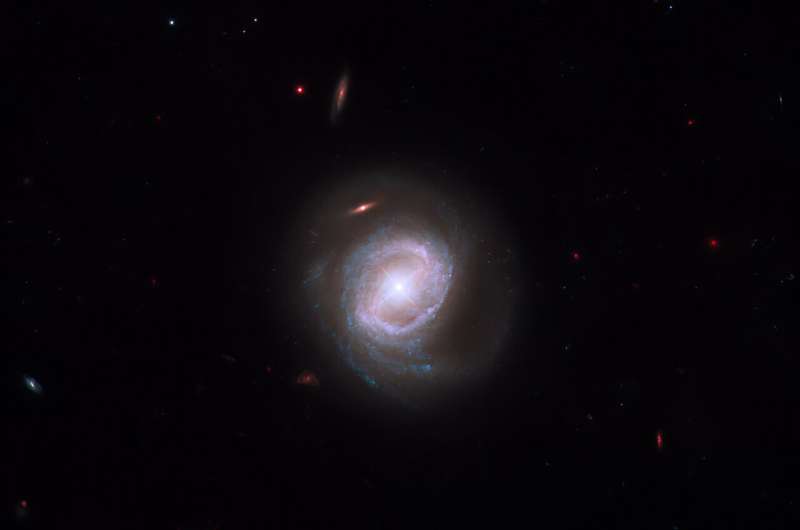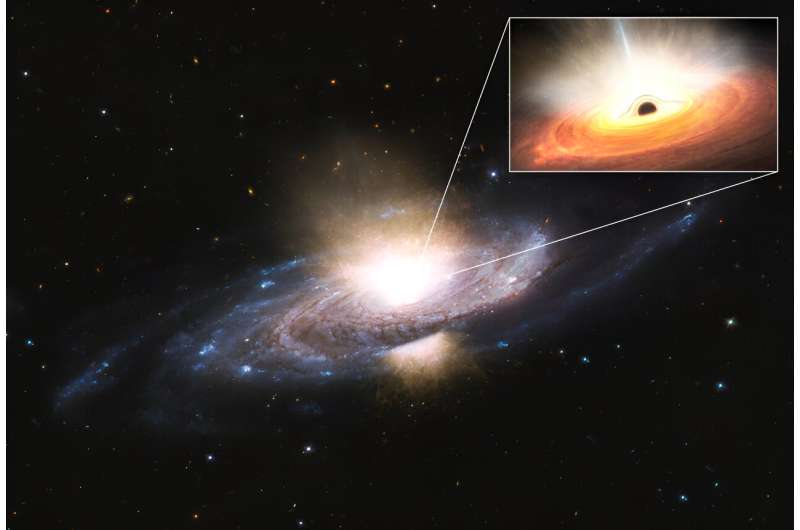This article has been reviewed according to Science X's editorial process and policies. Editors have highlighted the following attributes while ensuring the content's credibility:
fact-checked
peer-reviewed publication
proofread
XMM-Newton spots a black hole throwing a tantrum

Black holes are like temperamental toddlers. They spill food all the time, but ESA's XMM-Newton has caught a black hole in the act of "flipping over the table" during an otherwise civilized meal.
This act prevents the galaxy surrounding the black hole from forming new stars, giving us insight into how black holes and galaxies co-evolve.
At the heart of every large galaxy lies a supermassive black hole, whose immense gravity draws in gas from its surroundings. As the gas spirals inwards, it bunches up in a flat "accretion disk" around the black hole, where it heats and lights up. Over time, the gas closest to the black hole passes the point of no return and gets gobbled up.
However, black holes only consume a fraction of the gas spiraling towards them. While encircling a black hole, some matter is flung back out into space, much like how a messy toddler spills a lot of what lies on their plate.
In more dramatic episodes, a black hole will flip over the entire dinner table: Gas in the accretion disk gets flung out in all directions at such high speeds that it clears out the surrounding interstellar gas. Not only does this deprive the black hole of food, but it also means no new stars can form over a vast region, changing the structure of the galaxy.
Until now, this ultra-fast "black hole wind" had only been detected coming from extremely bright accretion disks, which are at the limit of how much matter they can draw in. This time, XMM-Newton detected ultra-fast wind in a distinctly average galaxy which you could say was "only snacking." The finding is reported in The Astrophysical Journal Letters.
"You might expect very fast winds if a fan was turned on to its highest setting. In the galaxy we studied, called Markarian 817, the fan was turned on at a lower power setting, but there were still incredibly energetic winds being generated," notes undergraduate researcher Miranda Zak (University of Michigan), who played a central role in this research.
"It is very uncommon to observe ultra-fast winds, and even less common to detect winds that have enough energy to alter the character of their host galaxy. The fact that Markarian 817 produced these winds for around a year, while not being in a particularly active state, suggests that black holes may reshape their host galaxies much more than previously thought," adds co-author Elias Kammoun, astronomer at the Roma Tre University, Italy.

X-rays blocked by the wind
Active galactic centers send out high-energy light, including X-rays. Markarian 817 stood out to the researchers because it went awfully quiet. Observing the galaxy using NASA's Swift observatory, Miranda recounts, "The X-ray signal was so faint that I was convinced I was doing something wrong."
Follow-up observations using ESA's more sensitive X-ray telescope XMM-Newton revealed what was really happening: Ultra-fast winds coming from the accretion disk were acting like a shroud, blocking out the X-rays sent out from the immediate surroundings of the black hole (called the corona). These measurements were backed up by observations made with NASA's NuSTAR telescope.
A detailed analysis of the X-ray measurements showed that, far from sending out a single "puff" of gas, the center of Markarian 817 produced a gusty storm over a wide area in the accretion disk. The wind lasted for several hundreds of days and consisted of at least three distinct components, each moving at several percent of the speed of light.
This solves an open puzzle in our understanding of how black holes and the galaxies around them influence one another. There are many galaxies—including the Milky Way—that appear to have large regions around their centers in which very few new stars form. This could be explained by black hole winds that clear out the star-forming gas, but this only works if the winds are fast enough, sustained for long enough, and are generated by black holes with typical levels of activity.
"Many outstanding problems in the study of black holes are a matter of achieving detections through long observations that stretch over many hours to catch important events. This highlights the prime importance of the XMM-Newton mission for the future. No other mission can deliver the combination of its high sensitivity and its ability to make long, uninterrupted observations," says Norbert Schartel, ESA's XMM-Newton project scientist.
More information: Miranda K. Zak et al, Fierce Feedback in an Obscured, Sub-Eddington State of the Seyfert 1.2 Markarian 817, The Astrophysical Journal Letters (2024). DOI: 10.3847/2041-8213/ad1407
Journal information: Astrophysical Journal Letters
Provided by The Cyprus Planetarium





















